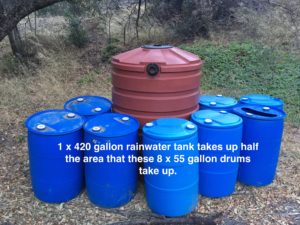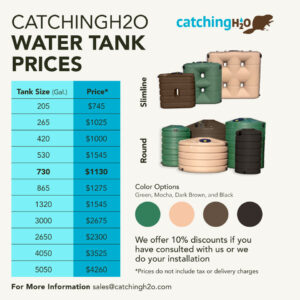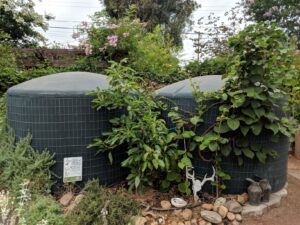In last week’s article we discussed the fact that water in San Diego is relatively cheap, so it’s hard to justify expensive rainwater harvesting strategies.
This week we will look at how to optimize your investment in rainwater harvesting.
- The number one way to optimize your water investment is to USE LESS! Did you know over 65% of our residential water use is for our landscapes? Chances are you can’t store enough rainwater in tanks to take care of all your landscaping needs. Start by picking parts of your yard to transition to lower water use plantings like California Natives so you can focus your water resources on your most precious plants like those that provide food, shade, or pollinator benefits. Then optimize your irrigation so that you are irrigating as efficiently as possible.
- You don’t need to buy a container to get great use out of your rainwater. Instead consider how to direct and store rainwater in the ground (like a battery), where the soil retains the moisture for long after it stops raining and the plants will have access to that moisture through their roots. You can increase your soil and plant health year over year AND keep stormwater out of the storm drains during rain events reducing pollution in our waterways and flooding in our communities.
- Now that you need less water, you need to do the math to better understand
- how much water is actually coming off your roof – A 1000 square foot roof sheds 600 gallons in one inch of rain. It rains about 10 inches on average per year in San Diego coastal cities, more like 12″ inland along the 15 corridor, and 14″ – 18″ further north and inland
- how much water you need – Consider a typical backyard fruit tree in our region may require 25-50 gallons. Also a 500 square foot lawn requires about 10,000 gallons of water a year to stay green. How long is 1000 gallons of rainwater going to last you? 5000 gallons? 50 gallons?
and how much space you want to give up to store water – a 500 gallon tank has a 4′ diameter. Like a small outdoor table? Can you fit that somewhere around your house.
- The single largest tank you can get is going to be cheaper than many smaller tanks. Notice a the 1320 gallon tank is $1545, but the 2650 gallon tank is $2,300. So to get the same capacity with two 1320 gallon tanks you would pay $3090, or $790 more.
Above ground round plastic tanks are the most economical compared to below ground, or metal, or rectangular tanks. We certainly don’t want more plastic in the world, but what we want even less is plastic with a short lifespan. Get a tank made for water storage, it’ll have UV rating, and then put it on the northside of the house or protect by growing vines or shrubs around it. The co-benefit is you can hide it!
- Once you know how much you want to store, consider how many downspouts you need to redirect to get your storage full in a few inches of rain. There may be no benefit to bringing multiple downspouts to your tank if you can fill it from one downspout in a few inches.
- Install the tank well, including filters, and using good materials to ensure that your setup will last over time. If we are installing things for sustainability reasons, we want to make sure our use of plastic is appropriate and that the water we are storing is good quality.Rainwater Harvesting This also means less maintenance over time which means you are saving time and money over the long term.
- Of course paying someone else to install your tank makes sense if you are short on time or skills. However, if you are handy, we have DIY resources for every level including .pdfs, parts lists, and even an hour or two of our time to help with the more technical aspects of the install. Or host a workshop: save money and make friends!
- Don’t forget to look for rebates!
- City of San Diego upped their rainwater rebate program so you can capture up to $800 ($1.50/gallon), plus there are gutter rebates available too!
- Everyone in San Diego County who has a water bill (not on well water) qualifies for up to $350 from socalwatersmart.com
- If you are in the unincorporated part of the county you may qualify for up to $2100 in rebates for both active (cistern) rainwater storage and passive (earthworks like swales/basins) water harvesting, as well as gutters. Check the map to see if you qualify. And check with us to optimize your returns!
- Finally, contact us for a consultation. We have been helping Southern Californians optimize water use and maximize their investments in onsite water resources since 2008. Our in depth consultations will help you understand where to start and how to best invest your time and money to maximize your water resilience! We can help you with an installation or direct you to the resources you need for the projects that make sense for you!

 and how much space you want to give up to store water – a 500 gallon tank has a 4′ diameter. Like a small outdoor table? Can you fit that somewhere around your house.
and how much space you want to give up to store water – a 500 gallon tank has a 4′ diameter. Like a small outdoor table? Can you fit that somewhere around your house. Above ground round plastic tanks are the most economical compared to below ground, or metal, or rectangular tanks. We certainly don’t want more plastic in the world, but what we want even less is plastic with a short lifespan. Get a tank made for water storage, it’ll have UV rating, and then put it on the northside of the house or protect by growing vines or shrubs around it. The co-benefit is you can hide it!
Above ground round plastic tanks are the most economical compared to below ground, or metal, or rectangular tanks. We certainly don’t want more plastic in the world, but what we want even less is plastic with a short lifespan. Get a tank made for water storage, it’ll have UV rating, and then put it on the northside of the house or protect by growing vines or shrubs around it. The co-benefit is you can hide it!